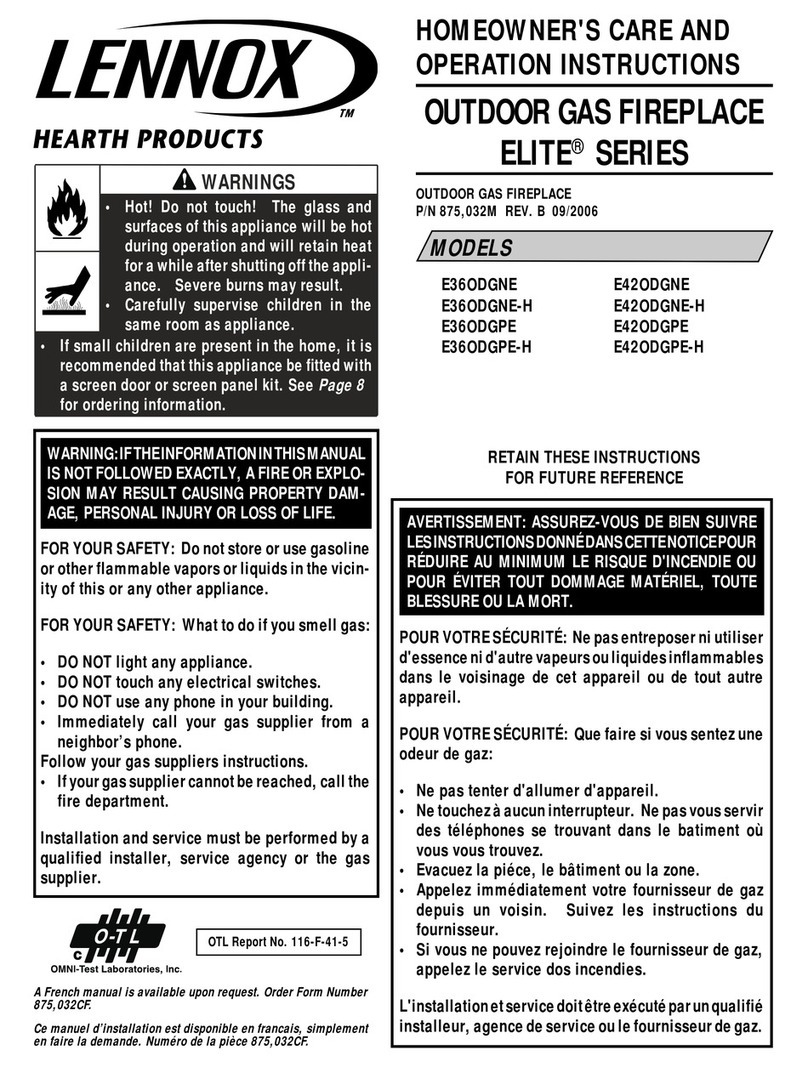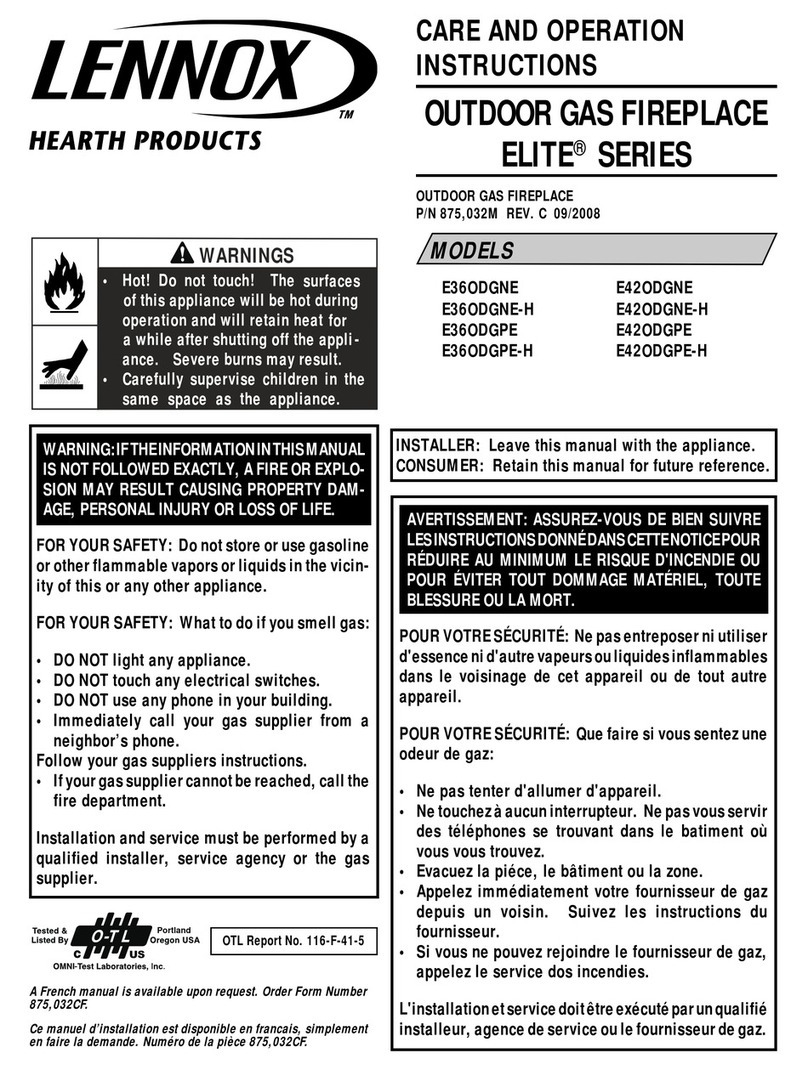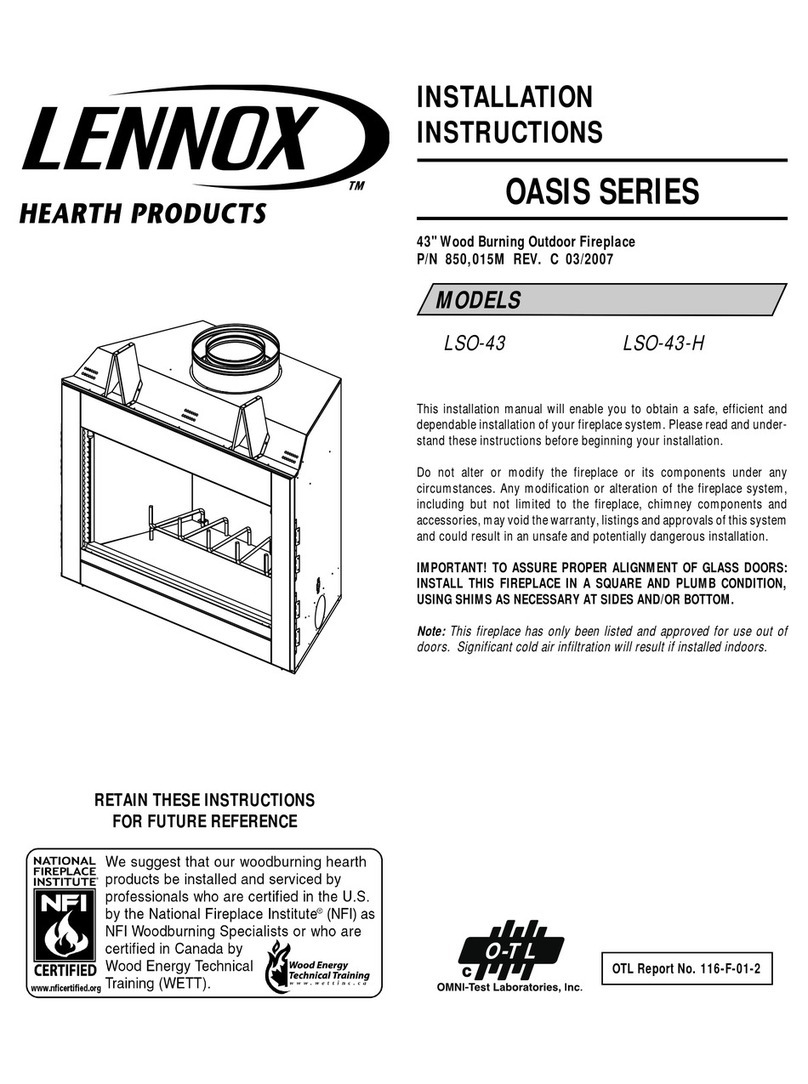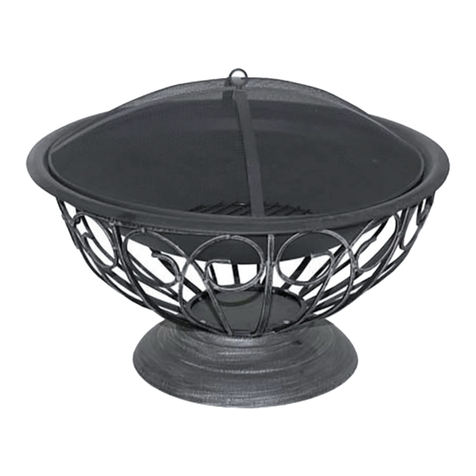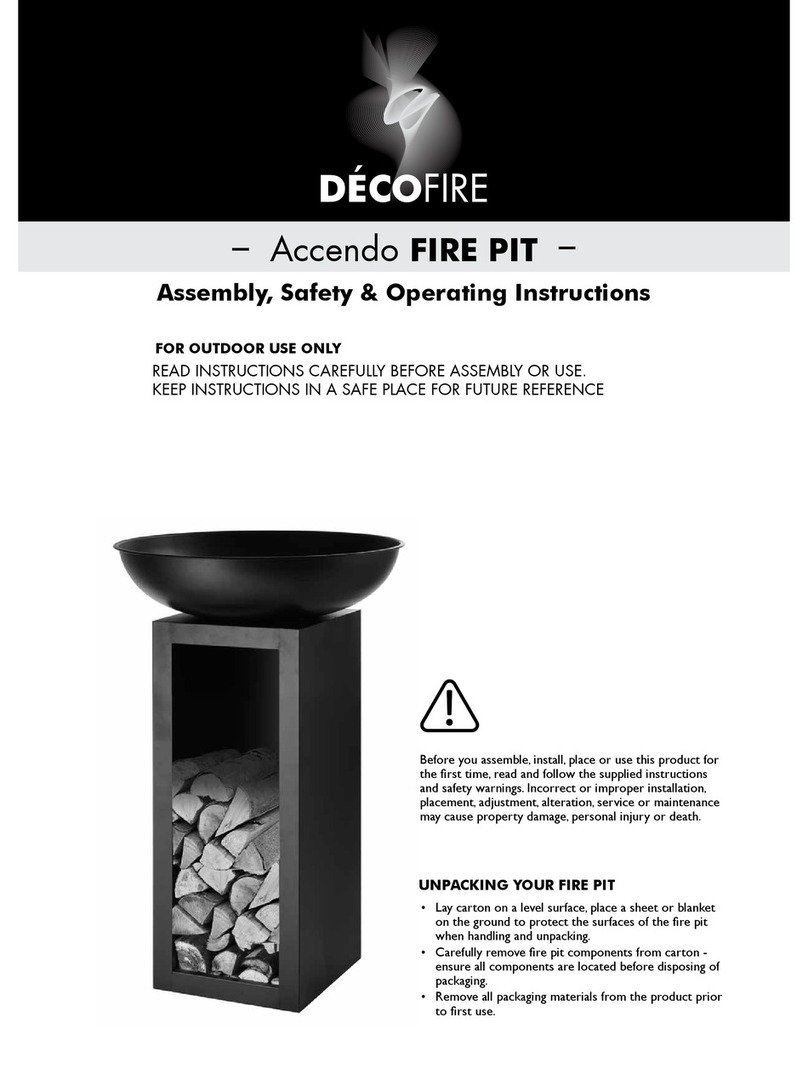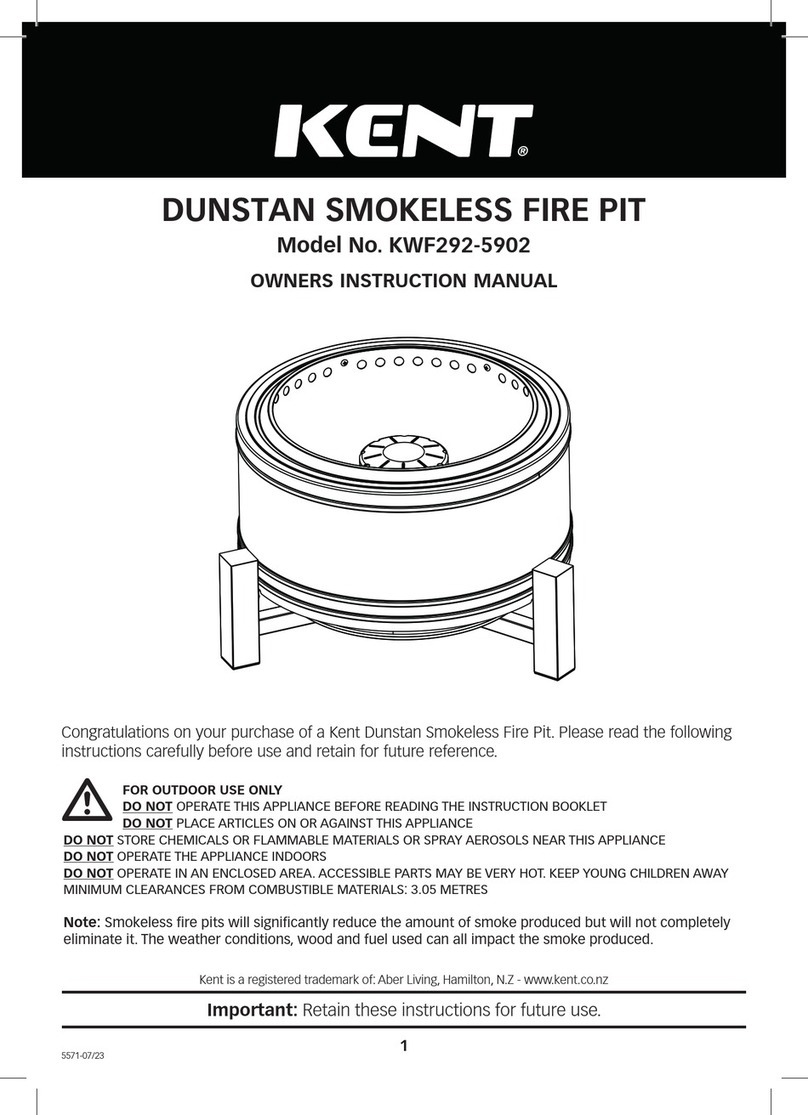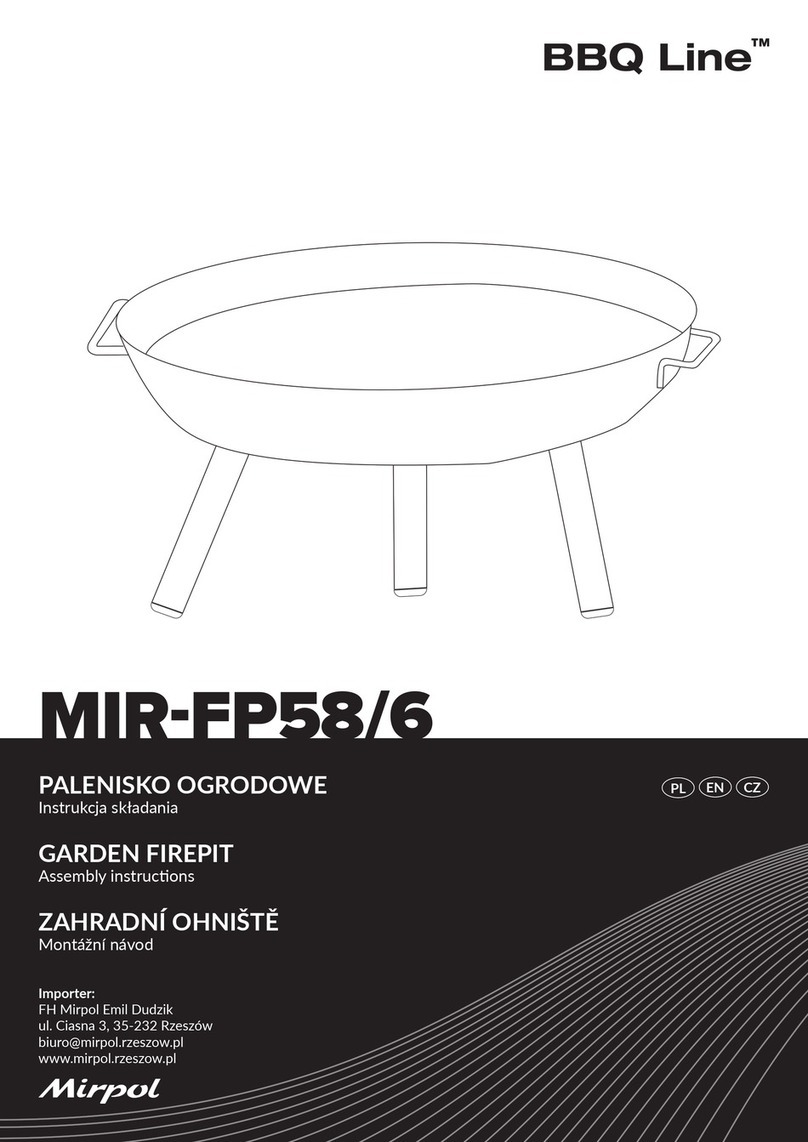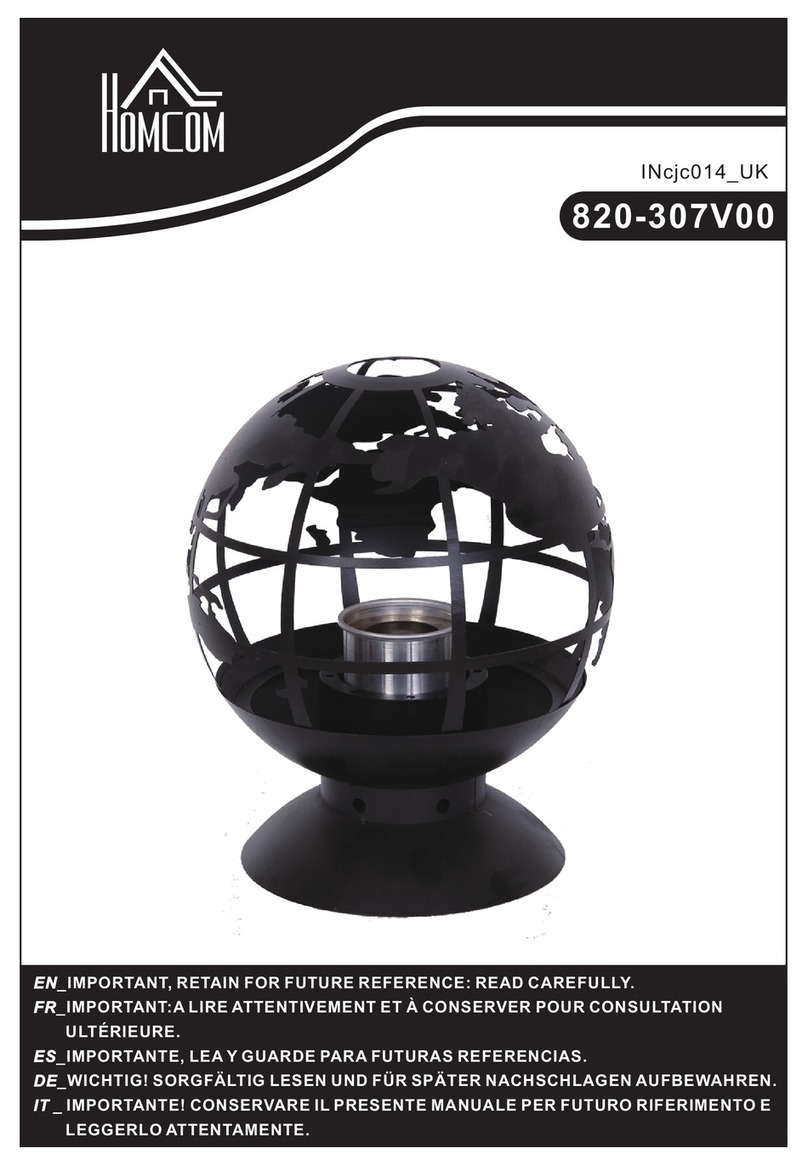Lennox Hearth Products ELITE E36ODGNE User manual

NOTE: DIAGRAMS & ILLUSTRATIONS NOT TO SCALE. 1
OUTDOOR GAS FIREPLACE
P/N 850,034M REV. D 04/2009
MODELS
OUTDOOR GAS FIREPLACE
ELITE®SERIES
INSTALLATION
INSTRUCTIONS
A French manual is available upon request. Order Form Number
850,034CF.
Ce manuel d’installation est disponible en francais, simplement en
faire la demande. Numéro de la pièce 850,034CF.
E36ODGNE E42ODGNE
E36ODGNE-H E42ODGNE-H
E36ODGPE E42ODGPE
E36ODGPE-H E42ODGPE-H
This appliance is only for use with the type of gas
indicated on the rating plate. This appliance is
not convertible for use with other gases, unless a
certified kit is used.
OTL Report No. 116-F-41-5
INSTALLER: Leave this manual with the appliance.
CONSUMER: Retain this manual for future reference.
US
Portland
INSTALLATEUR: Laissez cette notice avec l'appareil.
CONSOMMATEUR: Conservezcettenoticepourconsula-
tion ultérieure.
Do not store or use gasoline or other flammable
vapors or liquids in the vicinity of this or any
other appliance.
What to do if you smell gas:
• DO NOT light any appliance.
• DO NOT touch any electrical switches, do not
use any phone in your building.
• Immediately call your gas supplier from a
neighbor’s phone. Follow your gas suppliers
instructions.
• If your gas supplier cannot be reached, call
the fire department.
Installation and service must be performed by
a qualified installer, service agency or the gas
supplier.
WARNING:IFTHEINFORMATIONINTHISMANUAL
IS NOT FOLLOWED EXACTLY, A FIRE OR EXPLO-
SION MAY RESULT CAUSING PROPERTY DAM-
AGE, PERSONAL INJURY OR LOSS OF LIFE.
Ne pas entreposer ni utiliser d’essence ni d’autre
vapeurs ou liquides inflammables dans le voisinage
de cet appareil ou de tout autre appareil.
QUE FAIRE SI VOUS SENTEZ UNE ODEUR DE GAZ:
• Ne pas tenter d’allumer d’appareil.
• Netouchezàaucuninterrupteur. Nepasvousservir
des téléphones se trouvant dans le bátiment où
vous vous trouvez.
• Appelez immédiatement votre fournisseur de gaz
depuisunvoisin. Suivezlesinstructionsdufournis-
seur.
• Si vous ne pouvez rejoindre le fournisseur de gaz,
appelez le service des incendies.
L’installation et l’entretien doivent être assurés par
un installeur ou un service d’entretien qualifié ou par
le fournisseur de gaz.
AVERTISSEMENT: ASSUREZ-VOUS DE BIEN SUIVRE
LES INSTRUCTIONS DONNÉES DANS CETTE NOTICE
POUR RÉDUIRE AU MINIMUM LE RISQUE D’INCENDIE
D’EXPLOSION OU POUR ÉVITER TOUT DOMMAGE MA-
TÉRIEL, TOUTE BLESSURE OU LA MORT.

2NOTE: DIAGRAMS & ILLUSTRATIONS NOT TO SCALE.
Figure 1
Accessories
Wall Switch
Fireplace
Weatherproof
Enclosure
Optional Drain Pan
TABLE OF CONTENTS
Packaging .........................................page 2
Introduction ......................................page 2
New York & Massachusetts
Requirements................................page 3
General Information ..........................page 3
Location............................................page 4
Waterproofing The Fireplace ............page 5
Appliance Clearances ........................page 5
Clearance Specifications ...................page 6
Fireplace Installation .........................page 7
Routing Gas Line ..............................page 7
Fireplace Specifications.....................page 8
Framing Specifications......................page 9
Field Wiring.......................................page 10
Connecting Gas Line ........................page 11
Installing The Logs............................page 12
Checking Appliance Operation ..........page 13
Firebox Finishes ................................page 13
Accessories And Components ..........page 14
Gas Conversion Kits .................. page 15
TYPICAL INSTALLATION
INTRODUCTION
These outdoor gas fireplaces are designed for
exterior applications. These appliances must
be installed outdoors.
2 - oneenvelope containingtheliteraturepack-
age which consists of the Homeowner's
manual, Installation Instructions and War-
ranty.
3 - three (3) bags of lave rock, envelope is
located in the firebox area.
4 - Electrical kit containing the wall switch
components, battery holder, box and cover
(see Field Wiring page 10).
This installation manual will help you obtain a
safe, efficient, dependable installation for your
appliance.
This manual is part of a set of two supporting
this product. Refer to manual 875,032M for
Care And Operations.
Please read and understand these
instructions before beginning your
installation.
The appliance, when installed, must be electri-
callygroundedinaccordancewithlocalcodesor,
in the absence of local codes, with the National
Electrical Code, ANSI/NFPA 70, or the Canadian
Electrical Code, CSA C22.1.
DO NOT ATTEMPT TO ALTER OR MODIFY
THE CONSTRUCTION OF THE APPLIANCE OR
ITS COMPONENTS. ANY MODIFICATION OR
ALTERATION MAY VOID THE WARRANTY,
CERTIFICATION AND LISTINGS OF THIS
UNIT.
Electronic appliances are designed to oper-
ate on natural gas or propane. An electronic
intermittent pilot ignition system provides safe,
efficient operation. A battery pack is required
to operate these units.
These appliances comply with National Safety
Standards and are tested by Omni Test Labo-
ratories (Report No. 116-F-41-5) and listed by
CSA-4-96 in both USA and Canada, as outdoor
gas fireplaces.
The Installation must conform to local codes or,
in the absence of local codes, with the National
Fuel Gas Code, ANSI Z223.1/NFPA 54, or the
Natural Gas and Propane Installation Code,
CSA B149.1.
PACKAGING
The assembled outdoor gas fireplace is pack-
aged with the following:
1 - the logs are packaged in a carton located
within the firebox.
TheLennoxElite®SeriesOutdoorGas Fireplace
is designed for outdoor use. It may also be
installed in screened porches and lanais that
meet these minimum requirements:
Minimum porch area - 96 square feet
Minimum ceiling height - 7 feet 8 inches
A minimum of two (2) walls can be screened
but must be open to outside ventilation.
Minimum screen area - 64 square feet
Minimum screen top height - 6 feet 8 inches
Refer to Clearance Specifications on Page 6.

NOTE: DIAGRAMS & ILLUSTRATIONS NOT TO SCALE. 3
evlaVsaGdetaludoM-yllaunaMhtiwsledoM
saGlarutaN saGenaporP
.oNledoM
tupnI
etar
)H/UTB(
.oNledoM
tupnI
etar
)H/UTB(
GDO63E
000,05
ot
005,93
GDO63E
000,64
ot
000,73
GDO24E
000,05
ot
005,93
GDO24E
000,64
ot
000,73
Table 2
Inlet Gas Supply Pressure
(all models)
Fuel # Minimum Maximum
Natural Gas 5.0" WC
(1.24 kPa)
10.5" WC
(2.61 kPa)
Propane 11.0" WC
(2.74 kPa)
13.0" WC
(3.23 kPa)
Manifold Gas Supply Pressure
(all models)
Fuel # Low High
Natural Gas (Lo) 2.2" WC
(.55 kPa)
(Hi) 3.5" WC
(.87 kPa)
Propane (Lo) 6.3" WC
(1.57 kPa)
(Hi) 10.0" WC
(2.49 kPa)
Table 3 Table 4
Test gage connections are provided on the
front of the gas control valve identified IN for
the inlet and OUT for the manifold side. A
1/8" NPT Test gauge connection is provided at
the inlet and outlet side of the electronic gas
control valve.
All Models -
Allmodelshaveamanuallymodulatedgasvalve.
Input is shown in Table 1:
Gas Pressure - All Models
Tables 2 and 3 show the appliances' inlet and
manifold gas pressure.
GENERAL INFORMATION
Note: Installation and repair should be per-
formed by a qualified service person. The appli-
anceshouldbe inspectedannuallyby a qualified
professional service technician. More frequent
inspections and cleanings may be required due
to yard care, insects, etc. It is imperative that
the control compartment and burners of the
appliance be kept clean.
Provide adequate clearances around air open-
ings and adequate accessibility clearance for
service and proper operation. Never obstruct
the front openings of the appliance.
These appliances are designed to operate on
natural or propane gas only.
WARNING: PROPANE TANKS ARE AT
PRESSURES THAT WILL CAUSE DAM-
AGE TO VALVE COMPONENTS. VERIFY
THAT THE TANKS HAVE STEP DOWN
REGULATORS TO REDUCE THE PRES-
SURE TO SAFE LEVELS.
Table 1
These appliances must be isolated from the
gas supply piping system (by closing their
individual manual shut-off valve) during any
pressure testing of the gas supply piping
system at test pressures equal to or less than
1/2 psig (3.5 kPa).
These appliances and their individual shut-off
valves must be disconnected from the gas sup-
ply piping system during any pressure testing
of that system at pressures greater than 1/2
psig (3.5 kPa).
Orifice Sizes - Sea Level To High Altitude
(All Models)
These appliances are tested and approved for
installation at elevations of 0-4500 feet (0-1372
meters) above sea level, using the standard
burner orifice (See Table 4 ). For elevations
above 4500 feet, contact your gas supplier or
qualified service technician. Install the appli-
ance according to the regulations of the local
authorities having jurisdiction and, in the USA,
the National Fuel Gas Code NFPA 54 / ANSI
Z223.1 - latest edition or , in Canada, the CAN1-
B149.1 and .2 codes - latest edition.
Model
No.
Orifice size Elevation
Feet
(meters)
Natural
Gas Propane
E36ODG 0.1405"
(#28)
0.0785"
(#47) 0-4500
(0-1372)
E42ODG 0.1405"
(#28)
0.0785"
(#47)
NEW YORK AND MASSACHUSETTS
REQUIREMENTS
These appliances may be installed in the
following USA locations with the following
requirements:
Installation of these appliances are approved
for installation in the US state of Massachu-
setts if the following additional requirements
are met -
• Installation and repair must be done by a
plumber or gas fitter licensed in the Common-
wealth of Massachusetts.
• The flexible gas line connectors shall not
exceed 36 inches (92 centimeters) in length.
• The individual manual shut-off must be a
t-handle type valve.

4NOTE: DIAGRAMS & ILLUSTRATIONS NOT TO SCALE.
Figure 2
Whenlocatingthefireplace,considerationmust
be given to combustibles and final finishing.
See Figure 18 and confine the final location
of combustible finish materials to the "Safe
Zone". Also refer to Clearance Specifications
on page 6.
Consider the effects of heat when locating
any object in front of or near the fireplace
opening.
PRE-INSTALLATION NOTES
The fireplace may be installed directly on a
combustible floor or raised on a platform of an
appropriate height. Do not place the fireplace
on vinyl or other soft floor coverings. It may,
however, be placed on flat wood, plywood,
particle board or other hard surfaces.
Position the electrical junction box as detailed
in LOCATION OF FIREPLACE. (The umbilical
cord is 9 feet long).
Be sure the fireplace rests on a solid continu-
ous floor or platform with appropriate framing
for support.
The fireplace may be positioned and then the
framing built around it, or the framing may be
constructed and the fireplace positioned into
the opening.
Usually, no special floor support is needed for
the fireplace, however, to be certain:
1.Estimate the total weight of the fireplace sys-
temincluding surroundmaterialssuchasbrick,
stone,etc.,tobeinstalled. Shippingweightsfor
the fireplace may be found on page 8.
2.Measurethe squarefootageofthefloorspace
to be occupied by the system, surrounds and
hearth extensions.
3. Note the decking construction, i.e. 2 x 6’s,
2 x 8’s or 2 x 10’s, single or double joists, type
and thickness of floor boards.
4. Use this information and consult your local
building code to determine if you need ad-
ditional support.
If you plan to raise the fireplace and hearth
extension, build the platform assembly then
position fireplace and hearth extension on
top. Secure the platform to the floor to prevent
possible shifting.
ASSEMBLY STEPS
Note: The following steps represent the normal
sequence of installation. Each installation is
unique, however, and might require a different
sequence.
1. Position firebox prior to framing or into
prepared framing (non-combustible framing
is recommended).
2.Positiontheelectricaljunctionboxas detailed
in LOCATION OF FIREPLACE.
(The umbilical cord is 9 feet long).
3.Waterproofthefireplaceorinstallthe optional
drip pan (see Waterproofing The Fireplace and
Figure 3 on page 5 ).
4.Plumbgasline.(Gasconnectionsshouldonly
beperformedbyanexperienced,licensed/certi-
fied tradesman.)
5. Complete the installation, finish wall mate-
rial, surround and hearth extension to your
individual taste.
6. Assemble and attach optional accessories.
Study the three dimensional illustration (Fig-
ure 1 ) to get a general idea of each element
of your fireplace system.
WATERPROOFING THE FIREPLACE
Although the fireplace is designed to operate
safely outdoors, rain may enter the hearth area,
condensation and can cause water to collect
inside the fireplace bottom.
To prevent water collection, the builder must
provide a means to drain water from under
the fireplace by building or installing a water
collector of the builders choice, before posi-
tioning the fireplace in its location.
Special care must be taken when the fireplace is
installed against an exterior wall. The enclosure
surrounding the fireplace on the sides and back
must be treated as an exterior wall.
Lennox does provide an optional drain pan to
assist weatherproofing the fireplace.
H4651 DPSS36 Drain Pan for E36ODG, H4652
DPSS42 Drain Pan for E42ODG.
ASSEMBLY OUTLINE
Before You Start
Check your inventory list to be sure you have
all the necessary parts supplied in good us-
able condition. Check also for any concealed
damage.
LOCATION OF FIREPLACE
Carefully select the proper location for any
obstructions, clearance to side wall(s), air
availability, locationandaesthetics.Withproper
pre-planning,a slightadjustmentof afewinches
can save considerable time and expense later
during construction and assembly. See Figure
2for some examples.
When choosing a location, care must be taken
to avoid places where flooding or running water
may be a problem.
Identify the desired location for the battery
pack/ON/OFFswitch junction box location. This
should be easily accessible and convenient for
use and high enough on the wall to be protected
from water and drifted snow.
Do not use these appliances if any part of
the gas supply, control or burner has been
submerged under water. Immediately call a
qualified, professional service technician to
inspect the appliance and to replace any parts
of the control system and any gas control which
have been under water.
Carefully consider the position of the fireplace
opening with respect to the location of adjacent
ornearbystairwells,doors, windows,walkways
and over hanging trees, patios and wires.
LIVING SPACE
PATIO
Optional
Hearth
Extension

NOTE: DIAGRAMS & ILLUSTRATIONS NOT TO SCALE. 5
When Planning for the installation of the fire-
place, the framing height must be increased
from 46-1/2 inches to 47-1/4 inches, when
installing the drain pan. An additional space
below the fireplace will also be required to
plumb a drain line.
Step1. Seal all joints, gaps and corners around
the bottom of the drain pan before positioning
the fireplace on its location (Figure 3 ).
Step2. On the exposed drain hole, install a PVC
threaded coupling reducer, 3/4" x 1/2" going
from the top of the pan down through the hole.
Apply a silicone-based sealant around the base
and threads before installation.
Step 3. Holding the reducer coupling with a
wrench, thread a 3/4", 90 degree, PVC elbow to
the reducer until it is tight to the metal.
Step 4. Add additional piping to route the drain
to an appropriate location.
Note: To assure proper drainage, the fireplace
must be installed on a leveled surface.
CLEARANCES
Minimum clearance to combustibles for the
fireplace is as follows; sides and back – 1/2"
(13mm), combustible floor – 0" (0mm), adja-
cent wall 6" (152mm), ceiling – 50" (1270mm).
Refer to Figure 4 on this page and Figure 18
on page 13 for more detail.
Note: Clearance behind the nailing flange for
both fireplace models is 1/2" (13mm).
Note: Adjacent wall considerations are for an
adjacent wall to only a single side. Walls should
not be placed at the minimum distance on both
sides of the fireplace. Allow at least 4 feet on
one side of the fireplace.
Figure 4
Figure 3
47 1/4
Drain Connector Detail
Threaded
Reducer
3/4 x 1/2
(PVC)
Threaded
Elbow 3/4
@ 90°
(PVC)
1/2” Airspace Clearance
To Sides And Back
No Material Within
The Face Opening
Noncombustables
May Overlap The Face
Combustable Materials
Allowed Flush With
The Face Front
No Combustables
Below The Top Spacers
Noncombustable
Material Only
Only
Noncombustable
Material May
Overlap The
Top Face
Do NOT Overlap
Material Within
The Face Opening
1/2”
Airspace
Clearance
To Back
TOP VIEW
SIDE VIEW
5”
Combustible Material
May Overlap The
Face Bottom Up To 2”
Below The Face Opening
No Material
Allowed in
This Area
1/2” Clearance
1/2” Airspace Clearance
To Sides And Back
Nailing Flange May
Make Direct Contact
With Combustible
Framing

6NOTE: DIAGRAMS & ILLUSTRATIONS NOT TO SCALE.
CLEARANCE SPECIFICATIONS
FP = FIREPLACE OPENING X= AIR SUPPLY INLET = AREAWHERE FIREPLACE IS NOT PERMITTED
FP
(See Note 2)
D
L
A
H
M
X
J or K
I
G
F
FP
FP
FP
FP
FP
B
B
B
A = 2 in. . . . . . . . . . clearances above grade,
veranda, porch, deck or
balcony.
B = 12 in. . . . . . . . . . clearances to window or door
that may be opened, or to
permanently closed window.
36 in. . . . . . . . . . vinyl windows or siding.
D = 47 in. . . . . . . . . . vertical clearance to unventi-
lated soffit or to ventilated soffit
located above the fireplace.
60 in. . . . . . . . . . vinyl clad soffits.
F = 9 in. . . . . . . . . . clearance to outside corner.
G = 6 in. . . . . . . . . . clearance to inside corner.
48 in. . . . . . . . . . vinyl windows or siding.
H = 3 ft. (Canada) . not to be installed above a gas
meter/regulator assembly within
3 ft (914 mm) horizontally from
the center line of the regulator.
I = 3 ft. (USA)
6 ft. (Canada)
clearance to service regulator
vent outlet and electric service.
J = 9 in. (USA)
12 in. (Canada)
clearance to non-mechanical air
supply inlet to building or the
combustion air inlet to any other
appliance.
K = 3 ft. (USA)
6 ft. (Canada)
clearance to a mechanical air
supply inlet.
L* = 54 in. . . . . . . . . . clearance above paved sidewalk
(See note 1) or a paved driveway located on
public property.
M** = 47 in. . . . . . . . . . clearance under veranda, porch,
deck, balcony or overhang.
Not allowed: . . . . . . vinyl.
P = 92 in.
* A fireplace shall not open directly above a sidewalk or paved
driveway which is located between two single family dwellings
and services both dwellings.
** Only permitted if veranda, porch, deck or balcony is fully open
on a minimum of 2 sides beneath the floor, or if the screened
porch guidelines are followed.
Note 1: Local codes or regulations may require different clearances.
Note 2: Fireplaces
in an alcove space (spaces open only on one
side and with an overhang) are permitted with the dimensions
specified for vinyl or non-vinyl siding and soffits. 1) There must
be a 3 ft minimum between terminations or between the
fireplace and termination. 2) All mechanical air intakes within
10 ft of the top of the fireplace opening must be a minimum of
3 ft below the top of the fireplace opening.
3) All gravity air intakes within 3 ft of the fireplace must
be a minimum of 1 ft below the face top opening.
This fireplace is approved for installation in screened porches with the
following guidelines:
Minimum porch area - 96 sq ft
Minimum ceiling height - 92 in.
Minimum of two walls must be screened or open
Minimum top of screen height, side walls - 6 ft 8 in.
Minimum screen area - 64 sq ft
Note: There may be some odor and small amounts of soot associated
with burning the fireplace in a screened porch. Ensuring good cross
draft ventilation and routine maintenance of the fireplace will maximize
comfort and cleanliness.
. . . .
. . . .
Q = 72 in.
C = 72 in. . . . . . . . . . clearance below an
opperable window. .
. . . .
C
P
G
Q
A

NOTE: DIAGRAMS & ILLUSTRATIONS NOT TO SCALE. 7
Right Side
Front Corner
Of Fireplace
Framing
3-3/4"
(95 mm)
1-3/4"
(44 mm)
Figure 5
Note: An addiional inlet has been provided on
the left side (see Figure 6 ).
Step 2. Level the firebox by checking the top
edge of the firebox. Shim if necessary.
Step 3. The fireplace should be secured to the
sideframingmembers,usingthefulllengthnail-
ing flange located on both sides of the fireplace.
Use 8d nails, or screws.
IMPORTANT: UNDER NO CIRCUMSTANCES
SHALL THE FIREBOX TOP SPACERS BE RE-
MOVED OR MODIFIED. THE HEADER MAY BE
INDIRECTCONTACTWITH THE TOPSPACERS
BUT MUST NOT BE SUPPORTED BY THEM OR
NOTCHED TO FIT AROUND THEM.
Step 4. Identify the desired location for the
battery pack/ON/OFF switch junction box.
This should be easily accessible and connivent
for use. Avoid installing where the opening
could be blocked by snow, bushes, etc. Also,
considerations need to be made to avoid water
infiltration. The electrical junction box must be
positioned within range of the electrical umbili-
cal cord (9 feet). Route the umbilical cord to
the box to ensure proper length. Secure the
umbilicalcordperappropriatelocal andnational
electrical codes.
FIREPLACE INSTALLATION
Step1. Frame these appliances as illustrated in
Figures 7 through 9. All framing details must
allow for a minimum clearance to combustible
framing members, as shown in Figure 4 on
page 5. Also refer to Fireplace Specifications
on Page 8. Headers may be in direct contact
with the appliance top spacers but must not be
supportedbythemornotchedtofitaroundthem.
All construction above the appliance must be
self supporting. DO NOT USE THE APPLIANCE
FOR STRUCTURAL SUPPORT.
Note: The framed depth from a framed wall,
must always be measured from a finished
surface. If a wall covering such as durrock is
to be attached to the rear wall, then the depth
must be measured from the wall surface. It is
important that this dimension be exact.
Note: Non-combustible framing members are
not required, but are recommended.
ROUTING GAS LINE
Route a 1/2" (13 mm) gas line along the inside
of the right side framing as shown in Figure
5. Gas lines must be routed, constructed and
made of materials that are in strict accordance
with local codes and regulations.
All appliances are factory-equipped with a
flexible gas line connector and 1/2 inch shutoff
valve. (See Figure 12 on page 11).

8NOTE: DIAGRAMS & ILLUSTRATIONS NOT TO SCALE.
FIREPLACE SPECIFICATIONS
Gas Line
Access -
(Both Sides)
Access Opening for
Umbilical Cord -
Right Side Only
Top View
A
C
B
1 (25)
7-1/16
(179)
Front View Right Side View
Top Stand-Off
Spacers (4
places)
5-3/4
(146) 5-3/4
(146)
Top of Firebox
Opening
Bottom of
Firebox
Opening
Dimensions - Inches (millimeters)
Model No. A B C
E36ODG 37
(940)
41-3/4
(1061)
23-1/2
(597)
43
(1092)
47-3/4
(1213)
29-1/2
(749)
E42ODG
1-3/4
28-1/2
(724)
41-5/16
(1049)
34-1/4
(870)
5
(127)
20
(508)
11-15/16
(303)
4-3/8
(111)
Left Side Gas Inlet
8-1/4
(210)
2
(51)
Model Ship. Weight (lbs) Shipping Volume
E36ODG
230 lbs 38 Cu. Ft.
Weight And Volume
200 lbs 35 Cu. Ft.
E42ODG
Figure 6

NOTE: DIAGRAMS & ILLUSTRATIONS NOT TO SCALE. 9
Figure 7
Opening E360DG
A42-3/4" (1086) 48-3/4" (1238)
B46-1/2" (1181) 46-1/2" (1181)
C23-9/16" (599) 29-9/16" (751)
D11-1/4" (286) 14-1/4" (362)
E63-1/2" (1613) 69-1/2" (1765)
F31-3/4" (807) 34-3/4" (883)
G20-1/2"( 521) 20-1/2"( 521)
H44-3/16" (1122) 49-1/8" (1248)
E420DG
Table 1 (This Table Corresponds To Figures 7,8 & 9.)
FRAMING SPECIFICATIONS
Figure 8
Figure 9
Figures 7, 8 & 9 Corespond To Table 1.
Header
A
B*
* Increase Framing Height By 3/4”
When Using Optional Drain Pan
Corner Installation
A
C
D
HF
G
E
Back Wall Of
Chase/Enclosure
Including Finishing
Materials If Any
Rough Framing Face
(Unfinished Shown)
C
G
A
Parallel Installation
Rough Framing Face
(Unfinished Shown)
Back Wall Of
Chase/Enclosure
Including Finished
Materials - If Any

10 NOTE: DIAGRAMS & ILLUSTRATIONS NOT TO SCALE.
FIELD WIRING
Caution: Labelallwirespriortodisconnection
when servicing controls. Wiring errors can
cause improper and dangerous operation.
Verify proper operation after servicing.
Refer to Figure 10 for the wiring schematic
for these fireplaces.
This fireplace is completely wired internally.
On the right hand side of the fireplace, at the
rear, are four (4) wires required to connect the
Battery and switch for operation.
Two brown wires are for the connection of the
switch. These are labeled SW and SW. A black
and red pair are for connection to the battery
pack. These are labeled (+) and (–).
These wires are for low voltage current. An
electrical box has been provided to contain both
the switch and battery pack. Mount the box in
an appropriate location within the length of the
wiring provided. Feed all four wires through
one of the lower inlets to the box. Connect the
switchwirestotheswitchandthecorresponding
(+), (–) to the battery holder.
Install two D-cell batteries (not provided) and
test the switch before closing the switch box
(refer to Figure 11 ). The igniter should spark
to the pilot when the switch is on.
Figure 10
Figure 11
Switch
Cover
Weather Seal
Orient Batteries Vertically
To Fit Within Box
INTERMITTENT ELECTRONIC WIRING DIAGRAM
BROWN
BROWN
BLACK
BATTERY
WALL SWITCH BOX
BLACK (SENSOR)
BLACK (IGNITOR)
SPARK TO PILOT IGNITOR
IGNITOR MODULE
3V
RED
PILOT
IN
OUT
VENT
LO
HI
TH
TP
TH
TP
IN
ORANGE (THTP)
BLACK (TP)
GREEN (TH)
LIMIT
SWITCH
UMBILICAL CORD (9 Feet)

NOTE: DIAGRAMS & ILLUSTRATIONS NOT TO SCALE. 11
CONNECTING GAS LINE
Codes require a shut-off valve mounted in the
supply line. Figure 12 illustrates two methods
for connecting the gas supply. The flex-line
method is acceptable in the U.S., however,
Canadian requirements vary depending on
locality. Installation must be in compliance
with local codes.
These appliances are equipped with a gas flex
line for use (where permitted) in connecting the
unit to the gas line. A gas flex line is provided
to aid in attaching the direct vent appliance to
the gas supply. The gas flex line can only be
used where local codes permit. See Figure 12
for flex line description. The flex line is rated for
both natural and propane gas. A manual shut off
valve is also provided with the flex line.
The gas control valve is located under the
refractory cover in front of the burner.
To access the valve, lift out the center refrac-
tory and remove the access cover (see Figure
13 ).
The control valves have a 3/8" (10 mm) NPT
thread inlet port.
Secure all joints tightly using appropriate
toolsandsealingcompounds(ensurepropane
resistant compounds are used in propane
applications).
Turn on gas supply and test for gas leaks, us-
ing a gas leak test solution (also referred to as
bubble leak solution). Note: Using a soapy
water solution (50% dish soap, 50% water)
is an effective leak test solution but it is not
recommended, because the soap residue that
is left on the pies/fittings can result in corro-
sion over time. Never use an open flame to
check for leaks.
A. Light the appliance (refer to the lighting
instructions label in the control compartment
or in the Homeowner's Care and Operation
Instructions).
B. Brush all joints and connections with the gas
leak test solution to check for leaks. If bubbles
are formed, or gas odor is detected, turn the
gas control knob to the “OFF” position. Either
tighten or refasten the leaking connection and
retest as described above.
C. When the gas lines are tested and leak free,
be sure to rinse off the leak testing solution.
Figure 12 - GAS CONNECTION
Figure 13 - VALVE ACCESS
Access
Cover
Control
Valve
Refractory
Cover
Gas Flex Line Connector
Gas
Stub
1/2" x 3/8" Flare
Shut-Off Valve
3/8" Flex Tubing
3/8" NPT x 3/8"
Flare Fitting
3/8" Nipple
3/8" Union
3/8" Close Nipple
3/8" Shut-Off Valve
1/2" x 3/8"
Reducer
Gas
Valve

12 NOTE: DIAGRAMS & ILLUSTRATIONS NOT TO SCALE.
WARNING:DO NOT OPERATE THE FIRE-
PLACE FOR ANY EXTENDED PERIOD
OF TIME WITHOUT THE LAVA ROCK IN
PLACE. THE PAN CAN OVER HEAT AND
MAY WARP AND THE FIREPLACE MAY
SHUT OFF AUTOMATICALLY.
Figure 15
Figure 14
Figure 16
Base Log
Rear Log
Top Center Log
Top Left Log
Top Right Log
INSTALLING THE LOGS
After verifying that the fireplace operates
properly, replace the cover and set the bottom
refractory components in place.
Use two (2) bags of lava rock to fill the bottom
oftheburner traytocompletelycovertheburner
tube. Level the rock evenly.
Place the rear log approximately centered as
shown in Figure 14.
Place the base log approximately as shown in
Figure 15.
The remaining logs can be placed across the
rear and base log approximately as shown in
Figure 16. The exact position of these logs
is not critical. Due to the nature of an outdoor
environment, the flame will never be strictly
controlled. You may need to reposition the logs
to get the effect you find most desirable.
A more detailed description is provided in the
Homeowners Care and Operations manual.
CAUTION: LOGS GET HOT WHILE THE FIRE-
PLACE IS IN OPERATION. DO NOT ATTEMPT
TO ADJUST OR MOVE THE LOGS WHILE THE
FIREPLACE IS HOT.

NOTE: DIAGRAMS & ILLUSTRATIONS NOT TO SCALE. 13
Figure 17
CHECKING APPLIANCE OPERATION
With gas line installed run initial system check-
out before installing any additional accesso-
ries. Follow the lighting instructions provided
in the Care and Operation Instructions.
Note: Lighting Instructions are also found on
the literature tag tied to the gas piping next
to the gas valve. To access the tag, open the
lower control compartment door (refer to
Figure 13 - Valve Access ).
When first lighting the appliance, it will take
a few minutes for the line to purge itself of
air. Once purging is complete, the pilot and
burner will light and operate as indicated in
the instruction manual. Subsequent lighting
of the appliance will not require such purging.
Inspect the pilot flame (remove logs, if neces-
sary, handling carefully).
After the logs have been placed and the
fireplace has been checked for proper flame
presentation, use the remaining rock to fill in
voids and spaces. Remember, you may need
to access the high/low flame control beneath
the refractory cover.
Electronic Appliance Checkout
To light the burner, turn ‘ON’ the remote wall
switch. The battery will energize a spark that
will light the pilot. The pilot flame will engulf
the sensor and open the main valve. Within
seconds the main burner will light. Ensure the
ignitor lights the pilot. The pilot flame should
engulf the sensor as shown in Figure 17.
Figure 18 Clearances To Combustibles
ELECTRONIC
Pilot
Hood
Sensor
Ignitor
6" Minimum
For Combustible
Materials
12" Max.
3-3/4" Max.
See Note
29" Min.
Wall
Switch
5"
Min.
Note: The Area Above The Face To The Top Of The Spacers
Must Be Non-Combustable Materials
FIREBOX FINISHES
There are a wide variety of "finished looks" for your outdoor fireplace, from formal wall decor with
elaborate mantels to rustic wood paneling or warm brick facings.
Only noncombustible materials like marble, stone, tile, brick, etc. may overlap the top and sides of
the front facing. Seal all joints between the black facing and wall surrounds to prevent air intrusion.
Use noncombustible caulking materials only to seal the metal facing to the surround material on
the finished wall. See Figure 18.
CAUTION: DO NOT BLOCK THE FACE OPENING ON THESE FIREBOXES. DOING SO MAY CREATE
A POTENTIAL FIRE HAZARD.
Carbon Monoxide Poisoning: Early signs of carbon monoxide poisoning are similar to the flu
withheadaches,dizziness and/or nausea.Ifyouhave thesesigns,obtainfresh airimmediately.
Turn off the gas supply to the appliance and have it serviced by a qualified professional, as
it may not be operating correctly.

14 NOTE: DIAGRAMS & ILLUSTRATIONS NOT TO SCALE.
Drain Pan
Cat. No. Model Description
H4651 DPSS36 Drain Pan (36)
H4652 DPSS42
Drain Pan
The drain pan is used with the appliance.
Drain Pan (42)
INSTALLATION ACCESSORIES
AND COMPONENTS

NOTE: DIAGRAMS & ILLUSTRATIONS NOT TO SCALE. 15
Remove Tube
Regulator
Orifice
Remove Clip
Shutter
Opening
Figure 19
In Canada:
THE CONVERSION SHALL BE CARRIED OUT
IN ACCORDANCE WITH THE REQUIREMENTS
OF THE PROVINCIAL AUTHORITIES HAVING
JURISDICTION AND IN ACCORDANCE WITH
THE REQUIREMENTS OF THE CAN1-B149.1
AND .2 INSTALLATION CODE.
LA CONVERSION DEVRA ÊTRE EFFECTUÉE
CONFORMÉMENT AUX RECOMMANDA-
TIONS DES AUTORITÉS PROVINCIALES
AYANT JURIDICTION ET CONFORMÉMENT
AUX EXIGENCES DU CODE D'INSTALLATION
CAN1-B149.1 ET.2.
Gas conversion kits are available to adapt your
appliance from the use of one type of gas to
the use of another. These kits contain all the
necessary components needed to complete the
task including labeling that must be affixed to
ensure safe operation.
Kit part numbers are listed here and the follow-
ing steps detail the conversion procedure.
GAS CONVERSION KITS
WARNING: THIS CONVERSION KIT SHALL BE
INSTALLED BY A QUALIFIED SERVICE AGENCY
IN ACCORDANCE WITH THE MANUFACTURER'S
INSTRUCTIONSANDALLAPPLICABLECODESAND
REQUIREMENTS OF THE AUTHORIZED HAVING
JURISDICTION. IF THE INFORMATION IN THESE
INSTRUCTIONS IS NOT FOLLOWED EXACTLY, A
FIRE, EXPLOSION OR PRODUCTION OF CARBON
MONOXIDE MAY RESULT CAUSING PROPERTY
DAMAGE, PERSONAL INJURY OR LOSS OF LIFE.
THE INSTALLATION IS NOT PROPER AND COM-
PLETEUNTILTHEOPERATIONOFTHECONVERTED
APPLIANCE IS CHECKED AS SPECIFIED IN THE
OWNER INSTRUCTIONS SUPPLIED WITH THE KIT.
THE QUALIFIED SERVICE AGENCY PERFORMING
THIS INSTALLATION ASSUMES RESPONSIBILITY
FOR THIS CONVERSION.
AVERTISSEMENT: CET ÉQUIPEMENT DE CONVERSION
SERA INSTALLÉ PAR UNE AGENCE QUALIFIÉE DE
SERVICE CONFORMÉMENT AUX INSTRUCTIONS DU
FABRICANT ET TOUTES EXIGENCES ET CODES APPLI-
CABLES DE L'AUTORISÉS AVOIR LA JURIDICTION. SI
L'INFORMATIONDANS CETTE INSTRUCTION N'EST PAS
SUIVIEEXACTEMENT,UNFEU,EXPLOSIONOUPRODUC-
TION DE PROTOXYDE DE CARBONE PEUT RÉSULTER
LE DOMMAGES CAUSER DE PROPRIÉTÉ, PERTE OU
BLESSURE PERSONNELLE DE VIE. L'AGENCE QUALI-
FIÉEDE SERVICE EST ESPONSABLEDEL'INSTALLATION
PROPRE DE CET ÉQUIPMENT. L'INSTALLATION N'EST
PAS PROPRE ET COMPLÉTE JUSQU'À L'OPÉRATION
DE L'APPAREIL CONVERTI EST CHÉQUE SUIVANT LES
CRITÈRESÉTABLISDANS LES INSTRUCTIONS DE PRO-
PRIÉTAIRE PROVISIONNÉES AVEC L'ÉQUIPEMENT.
Step 1. Turn off the gas supply to the ap-
pliance.
Step 2. Carefully remove the logs. Exercise
care so as not to break the logs.
Step 3. Refer to Figure 19.
Remove the burner assembly with attached
venturi tube.
tiKnoisrevnoCsaGlarutaNotenaporP
.oNledoM epyTtinU golataC
.oN
GDO63E N041BD-KCG 5194H
GDO24E N041BD-KCG 5194H
noisrevnoCsaGenaporPoTlarutaN
tiK
sledoM
.oN epyTtinU .oNgolataC
GDO63E P870BD-KCG 6194H
GDO24E P870BD-KCG 6194H

16 NOTE: DIAGRAMS & ILLUSTRATIONS NOT TO SCALE.
Printed in U.S.A. © 2006 by Lennox Hearth Products
P/N 850,034M REV. D 04/2009
LennoxHearthProductsreservestherighttomakechangesatanytime,withoutnotice,indesign,
materials, specifications, prices and also to discontinue colors, styles and products.
Consult your local distributor for fireplace code information.
1110 West Taft Avenue • Orange, CA 92865
Figure 21
Figure 20
Figure 22
Note: If the ignitor is damaged, a replace-
ment kit is available, order Catalog Number
87L54.
Electronic Appliances
Step 4. Dexen Electronic Valves - See Figure
20 and the instructions provided with the kit.
Remove and discard the two pressure regulator
mounting screws. Removethepressureregula-
torand diaphragm. Discardall removedcompo-
nents. Ensure the rubber gasket installed on
thebackofthereplacementpressureregulator
isproperlypositioned.Installthenewpressure
regulatorusingthenewscrewssuppliedwiththe
kit. Tighten screws to 25 In. lb. torque.
Note: Naturalgasregulatorsareidentifiedwitha
blue dot. Propane regulators have a red dot.
Step 5. See Figure 21 and replace the pilot
orifice as follows: Remove pilot hood assembly
by grasping the hood and pulling the assembly
straight up. Under the hood is the pilot orifice.
With caution and using a magnetic screwdriver,
undo the pilot orifice and remove it from the
assembly. Carefully replace the orifice with the
one provided with the kit. Press the pilot hood
back over the assembly. The orientation should
be aligned as shown in Figure 21. Exercise
extreme care to prevent damage to or break-
age of the ignitor assembly.
Note: Propane pilot orifices are identified with a
countersink in the head. Natural gas orifices do
not have this countersink. See Figure 21.
Step 6. (Refer to Figure 19 on page 15 )
A. Remove the orifice from the manifold with
a 1/2" deep throat socket. See the following
table for orifice sizes for natural and propane
models. Figure 22 illustrates the orifice.
Use pipe joint compound or Teflon tape on all
pipe fittings before installing (ensure propane
resistant compounds are used in propane ap-
plications, do not use pipe joint compounds
on flare fittings).
B.Retrieve the burner and slide the venturi tube
over the orifice. Secure the burner in place with
the clip shown in Figure 19.
Step7.Reassemblethe remaining components
by reversing the procedures outlined in the
preceding steps.
ELECTRONIC PILOT
Pilot
Hood
Sensor
Ignitor
PROPANE NATURAL
.oNledoM ezisecifirO
laruta naporP
GDO63E 82#
.1405)
0(
GDO24E 82#
.1405)
0(
74#
.0785)
0(
74#
.0785)
0(
Ne
NOTE: DIAGRAMS & ILLUSTRATIONS NOT TO SCALE.
Pilot Stage
Terminal Pressure-Tap
(Inlet) Pilot Gas
Outlet
Supply
Gas
Inlet
Pressure-Tap
(Manifold)
Burner Stage
Terminal
Ground
(TP)
PILOT
OUT
VENT
LO
TH
TP
TH
TP
HI
IN
IN
Gas Outlet
To Burner
Regulator
Mounting Screw
Other manuals for ELITE E36ODGNE
1
This manual suits for next models
7
Table of contents
Other Lennox Hearth Products Outdoor Fireplace manuals
Popular Outdoor Fireplace manuals by other brands

Outdoor GreatRoom Company
Outdoor GreatRoom Company Sierra installation instructions
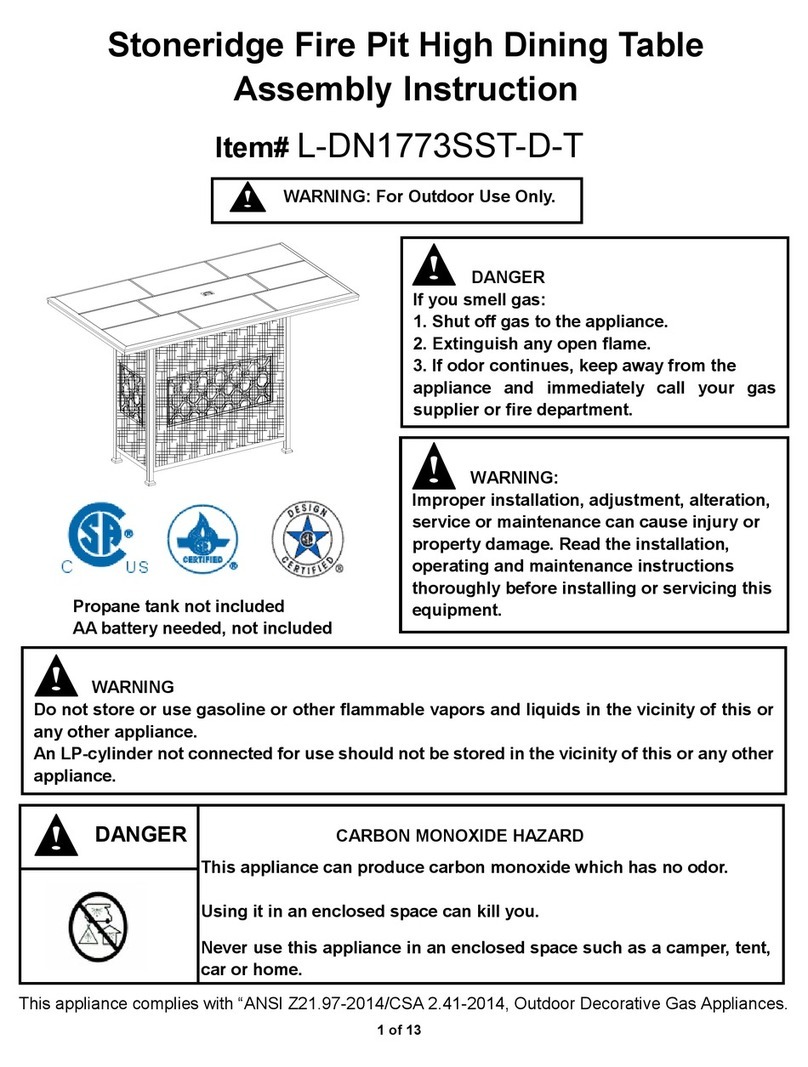
Sunjoy
Sunjoy Stoneridge L-DN1773SST-D-T Assembly instruction

for Living
for Living S-FT1238PST-C Assembly instructions
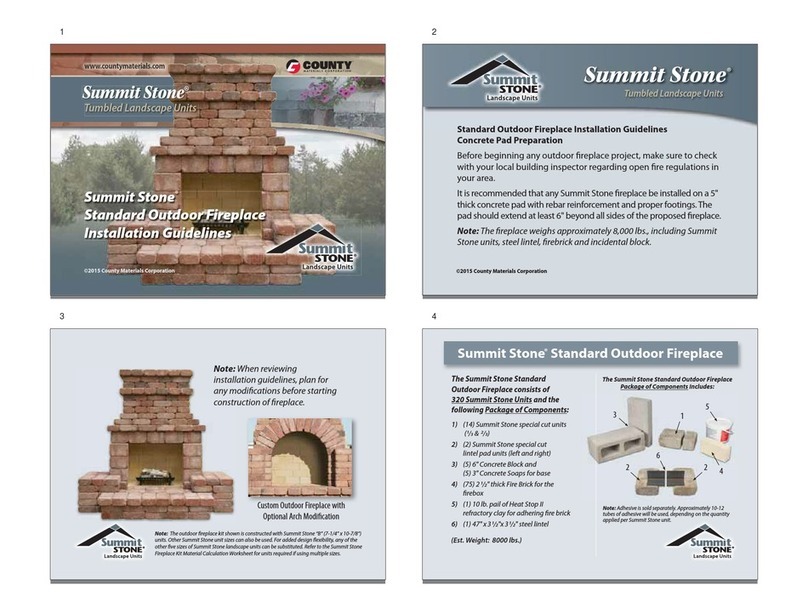
County Materials Corporation
County Materials Corporation Summit Stone Installation guidelines

Patio Premier
Patio Premier 101009 quick start guide
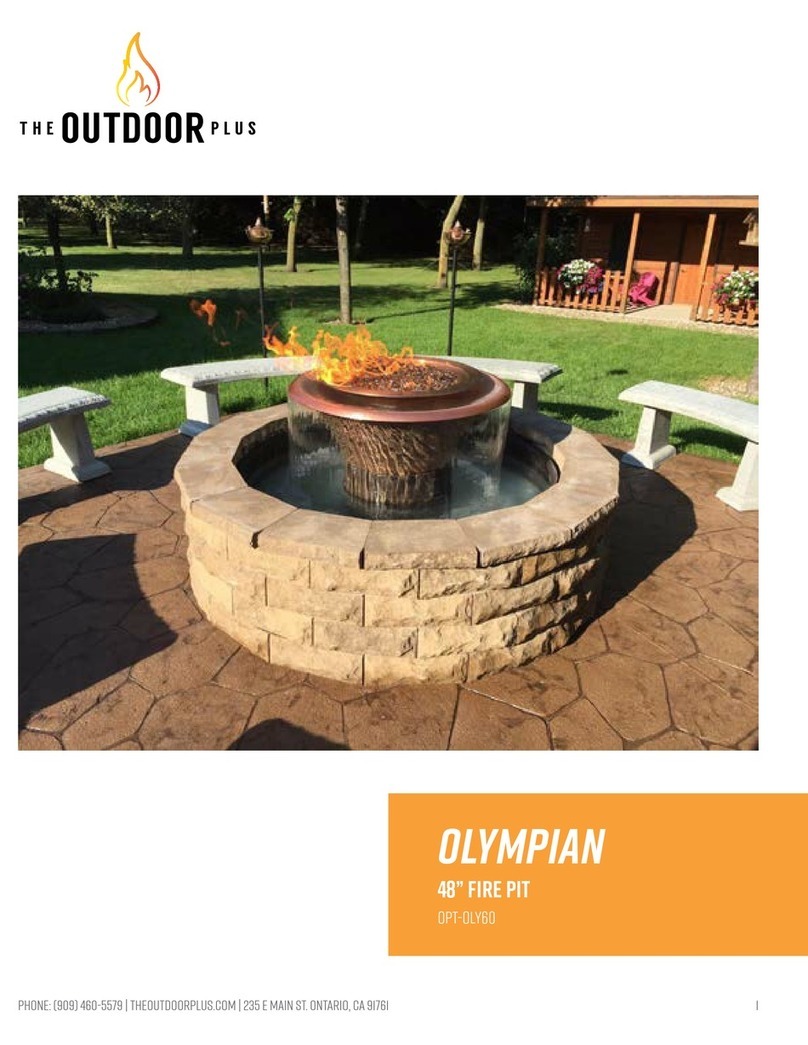
Outdoor Plus
Outdoor Plus OLYMPIAN OPT-OLY60 installation instructions
